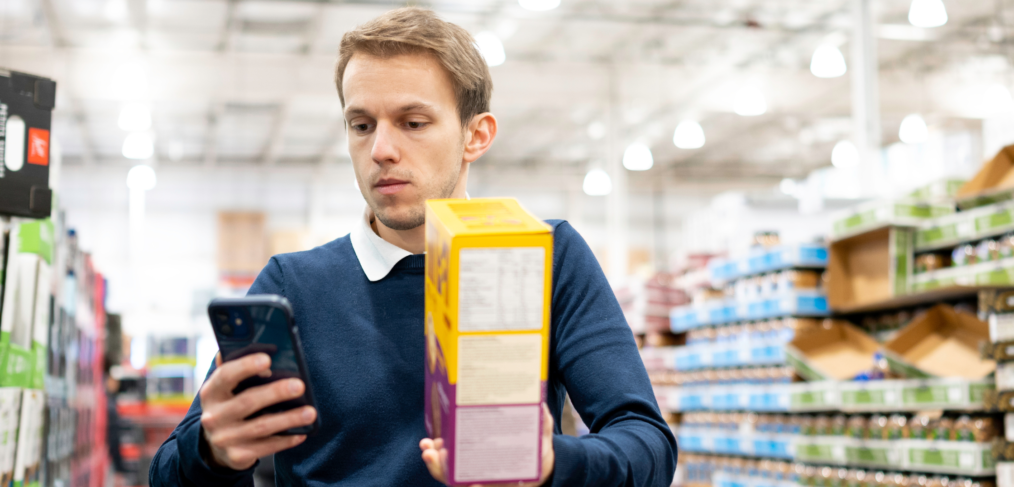
Connecting with the Uncommitted Consumer
The global food industry is currently navigating unprecedented challenges. Since the pandemic, the food inflationary environment has significantly impacted food brands, particularly in terms of customer brand loyalty and the notable shift towards more affordable or private label alternatives. In the United States, 71.7% of consumers view a brand less favorably following a price increase, with 60% expressing a willingness to seek out alternatives to get a bargain.[1] Closer to home, 75% of Canadians prioritize price in their purchasing decisions.[2]
The necessity for food brands to retain their customer base is evident in the current landscape of grocery sales within the United States. For the 27-week period concluding July 19th, unit sales remained flat, while category sales increased 2%, primarily driven by inflation.[3] These figures align with Circana’s updated forecast for U.S. grocery sales in 2025, in which they project a modest 0.2% unit growth and a 3.2% increase in dollar sales.[4] This imperative for food brands to secure their customer base is further underscored by Ernst & Young, in which they revealed 35% of consumers say that brand considerations no longer play a significant role in their product choices.[5] So how do Brands connect with this customer base?
Who is the Uncommitted Consumer?
The uncommitted consumer is a customer who routinely shops across different locations and formats, prioritizing their own needs over brand loyalty. Though price is an important factor in their everyday shopping decisions, it is not the only factor. In all, the uncommitted consumer is:[6]
- Value -Seeking: They are price sensitive and they seek to maximize their budget to provide for their family. Last year, 49.7% of all CPG unit sales in Canada were sold on promotion.[7] On average, they visit 3 grocery stores per month.
- Opportunistic: They make decisions about where to shop that fit into their lifestyle. In most instances, they come to a conclusion on the go. They are willing to change where they shop based on loyalty rewards programs.
- Digital: Their phone is their greatest ally. They compare prices to know where to shop. 39% of in-person grocery shoppers compare prices across banners, as compared to 48% of online grocery shoppers. Fifty-four percent (54%) of the uncommitted customer use every online resource to compare prices.
What is the Demographic Profile for the Uncommitted Consumer?
Uncommitted shoppers are prevalent across all demographics and income levels, primarily influenced by economic perceptions, particularly negative outlooks on the economy. This trend suggests a challenging environment for brands in Canada, given 73% of Canadian households anticipate their financial situation will remain stagnant or worsen in the coming year.[8] The customer’s significant price sensitivity often results in cross-shopping and a strong inclination to seek out deals. This behavior aligns with broader Canadian consumer values, in which nearly 50% actively look for sales and discounts, 25% utilize more coupons, and another 25% dedicate more time to online price comparisons.[9]
Is Brand Loyalty Today a Reality or a Dream?
It appears that consumers are finding it increasingly challenging to maintain loyalty to their preferred brands given the current economic climate. Sales Force research reveals 66% of consumers switch brands in response to a price increase. Broken down by gender:
- 81% of Millennials and Gen Z have switched brands over the past year, as compared to 74% of Gen X and 63% of Baby Boomers.[10]
How do You Connect with the Uncommitted Consumer?
Brands must implement a more integrated approach to consumer conversations. While these interactions are routine for existing consumers, engaging a new target audience directly presents increasing challenges. Brands must foster a sense of inclusion in these conversations and demonstrate that their input is valued. Brands must make them feel part of the conversation and acknowledge they are listening.
Food Distribution Guy’s Final Thoughts
The contemporary grocery environment necessitates that brands value every consumer purchase. Leave nothing to chance, and embrace the present, as 26% of consumers leave a brand after just one poor interaction, as compared to 16% in 2022.[11] The challenge of engagement with this consumer is significant. Here are three suggestions brands may wish to consider:
- Reevaluate Your Brand Identity: Specifically, consider whether your brand’s USP, Positioning, and Promise remain as relevant today as they were upon the brand’s introduction.
- Create a Compelling Brand Story: As Professor Jill Avery of Harvard Business School states, “Brands that tell compelling stories have the power to break through the clutter and truly engage their audience.”
- Create Compelling Innovative Products: Me-too products not welcome. While innovation is the foundation of any industry, it is noteworthy that “In 2009, the year of the global financial crisis, 51% of all new launches were true innovation. By 2016, this figure had declined to 38%”.[12]
References:
[1] Brand Loyalty is Declining, But the Death Knell Isn’t Ringing, www.foodnavigator.com, February 2025
[2] Brand Loyalty is Down, Value Up Among Canadian Grocery Shoppers: Survey, www.grocerybusiness.ca March 2025
[3] Retail Realities: Modest Food and Beverage Growth Amid Shifting Consumer Priorities, www.foodnavigator-usa.com, August 2025
[4] Circana Projects More of the Same in 2026, www.foodbusinessnews.net, August 2025
[5] Brand Loyalty Declines, Consumers More Open to Private Label, www.foodbusinessnews.com, May 2025
[6] Winning the Uncommitted Customer, www.upside.com, August 2025
[7] Navigating the Road Ahead, Carman Allison, Nielsen IQ, April 2025
[8] Canadian Consumer Insights to Navigate Turbulence, www.numerator.com, August 2025
[9] Canadian Turn to Sales, Coupons as Food Affordability Remains Top Concern: Report, www.canadiangrocer.com, October 2024
[10] Brand Loyalty is Fading Amongst Gen Z and Millennials, www.emarketer.com, April 2025
[11] New Survey Shows Gen Z is More Brand Loyal Than Gen X, www.zoom.com, July 2024
[12] Why is Innovation in Food and Beverage Declining, www.foodnavigator.com, August 2024





